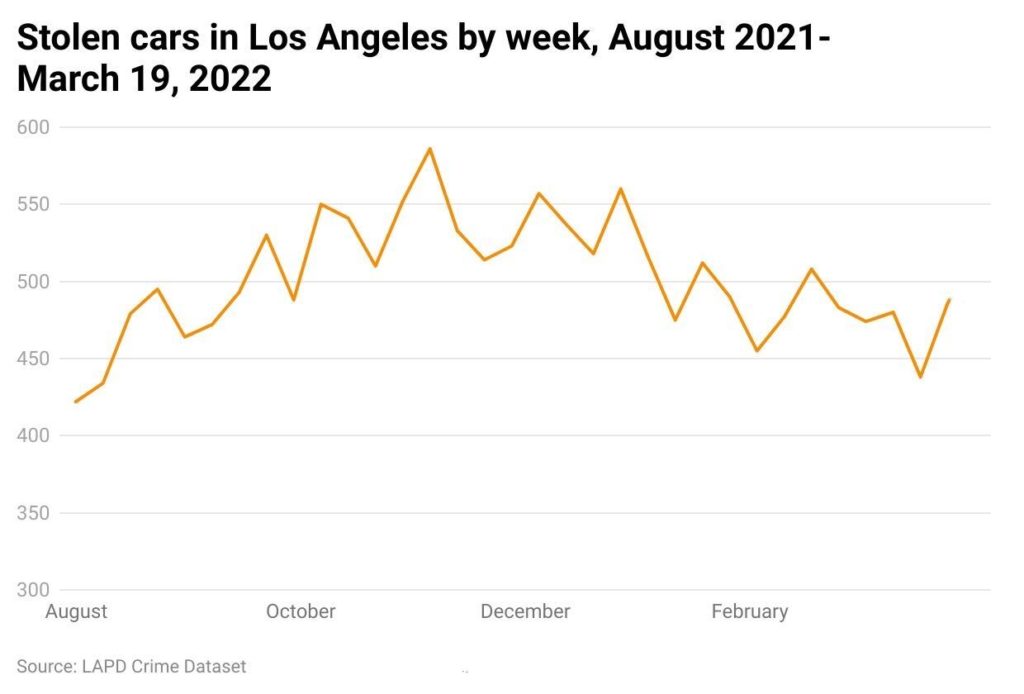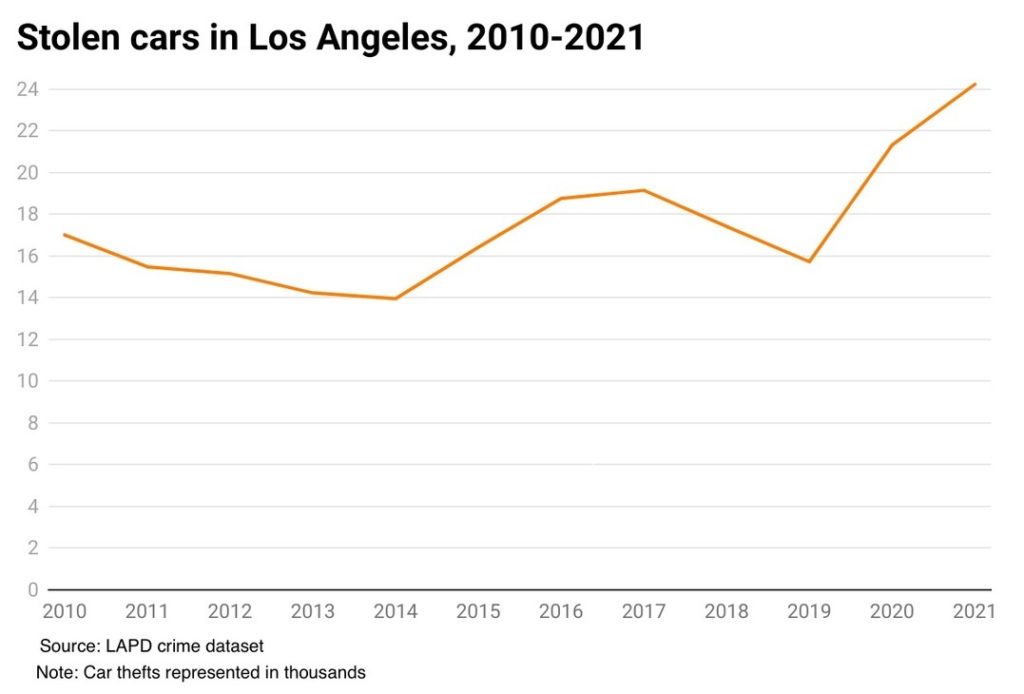Car thefts in Los Angeles may have peaked

In January, the Los Angeles Police Department recorded 2,140 car thefts. In February, another 1,937 vehicles went missing. Both rank among the eight highest monthly totals for stolen vehicles since the LAPD started making its data publicly available in 2010.
The numbers are alarming, though there is a silver lining—they mark declines from the end of 2021, which produced the three worst months ever for car thefts in the city. The apex occurred in October, when 2,388 vehicles were stolen.
While the current figures are far higher than before the pandemic, the first three months of 2022 indicate that the citywide epidemic of car thefts may have peaked. The last 13 weeks of 2021 all brought more than 500 weekly reports of stolen vehicles in Los Angeles. In the first 12 weeks of 2022, the plateau has only been hit twice.

No single factor likely explains the decrease. Copious reports of stolen vehicles may have spurred people to take better precautions. Another possibility is that with the pandemic continuing to ease, and people driving more, fewer vehicles sit on the street for extended periods, said LAPD Lt. S. Bruce Hosea, who works with the multi-agency Task Force for Regional Auto Theft Prevention (TRAP).
Hosea said certain types of vehicles continue to be particularly appealing for car thieves, and a video released by TRAP early this year mentioned that Hondas from 1995-2010, and Kia and Hyundai models from 2010-2021 consistently rank high on the list of vehicles stolen. So do certain GMCs and Chevy Silverados.
In the case of the Kia and Hyundai models, thieves have been able to easily override the locking mechanism. The video states, “As word has spread about the ease by which these vehicles are stolen, they are increasingly being targeted by thieves.”
Last year, Police Chief Michel Moore noted that some thefts are preventable, and occur when people park and walk away from the vehicle, not realizing that a key fob has been left in the cup holder. Some other thefts occurred when food delivery drivers left the engine running while taking items to a customer’s door.

Secondary Benefit
In addition to the obvious benefits of fewer vehicles being stolen, there is a secondary positive element: When car thefts decline over an extended period, insurance rates decrease, said William Lemmon of Broadway Insurance Service.
Lemmon said his company has found that stolen vehicles are often recovered. LAPD leaders have said the same thing, pointing out that many cars are found three to five days after they go missing, and often in the same neighborhood.
[Get COVID-19, crime and other stats about where you live with the Crosstown Neighborhood Newsletter]
Police officials have said this indicates that thieves are frequently using the stolen rides for transportation.
Hot wheels neighborhoods
From January 2021 through this March, 1,259 vehicles were reported stolen in Downtown, the highest number of any community in Los Angeles. But just as overall thefts have decreased in the city, they have declined in Downtown, too, from 107 in December to 95 in January to 89 in February.
In the same time period Boyle Heights saw the second greatest number of car thefts, with 973. Other neighborhoods where thieves were particularly active were Westlake (876), Koreatown (861) and Van Nuys (856).
Police officials point to common-sense steps people can take to keep their vehicle safe. Hosea suggested owners park in areas where they can see the car, always lock the vehicle, and double check to be sure that the fob is not left behind.
How we did it: We examined publicly available vehicle theft data from the Los Angeles Police Department from Jan. 1, 2010-March 19, 2022. We also looked at LAPD Compstat data. Learn more about our data here.
LAPD data only reflects crimes that are reported to the department, not how many crimes actually occurred. In making our calculations, we rely on the data the LAPD makes publicly available. LAPD may update past crime reports with new information, or recategorize past reports. Those revised reports do not always automatically become part of the public database.
Want to know how your neighborhood fares? Or simply just interested in our data? Email us at askus@xtown.la.






